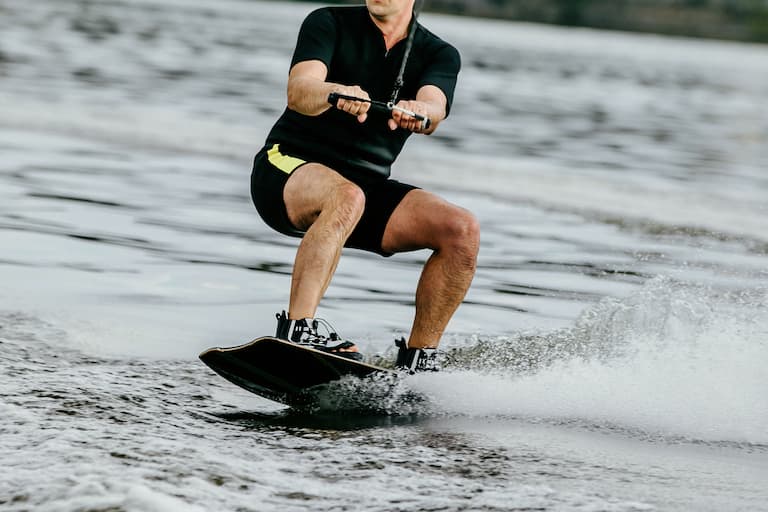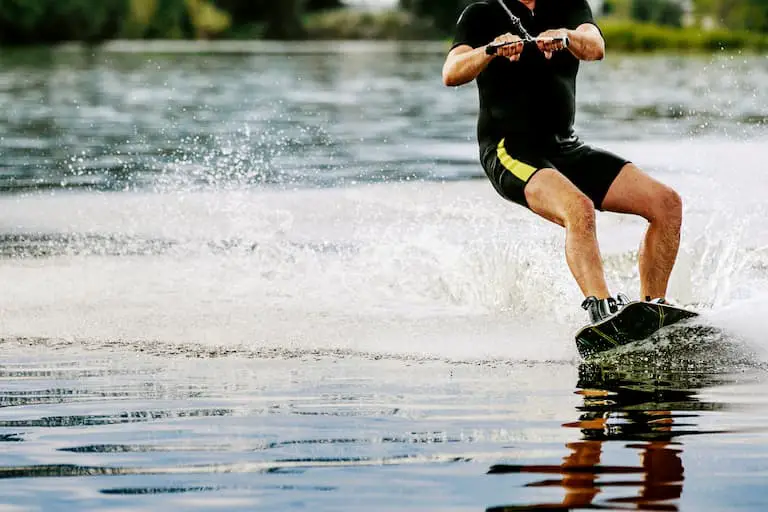What To Do When You Can’t Get Up on a Wakeboard? (w/ Video)
Wakeboarding looks complicated, but it can be quite simple to master. However, standing up on a wakeboard can be difficult for beginners. So, what should you do when you can’t get up on a wakeboard without tumbling over?
When you can’t get up on a wakeboard, keep your knees bent and arms straight, and balance your center of gravity on the board. Also, point your hips towards the tow rope while straightening out your knees as the boat speeds up, and shift 60% of your weight forward when standing up for better balance.
This article will walk you through the correct way to get up on a wakeboard. It will also give you valuable tips on how to stay up on a wakeboard if you’re always falling off. So, let’s get started!

How To Get Up on a Wakeboard
To get up on a wakeboard, balance your weight evenly, bend your knees so you’re squatting down (while laying in the water), and let the board do the work. As the boat gains speed, move your body weight from your toes to your heels. Avoid ” pushing” the board forward, as this will only cause you to fall off.
Here are some essential things to help you stay standing on a wakeboard:
Knee Position
Your knee position will affect your balance and your ability to stay up on a wakeboard. Always keep your knees bent and your chest inwards.
Remain in a squatting position with your knees close to your chest until the boat starts pulling the rope. Bending your knees helps you stay upright on the board by distributing your body weight evenly.

Grip Position
Correctly gripping the tow rope is essential to getting upright as the boat accelerates. Grip the rope with the palms facing down for a stronger grip and stability.
Keep your arms loose and relaxed, and maintain a steady grip. Also, avoid wrapping the tow line in your palms or tying a knot around the rope.
Weight Distribution
Try to maintain a balanced weight distribution in the center of your feet when you’re floating on the board. As the boat pulls forward, shift your weight slightly forward so that 60% of your weight is on the front foot.
You can balance your weight evenly when fully vertical on the board. Many experienced wakeboarders will constantly shift their weight to get a feel for the wake and change direction slightly.
Standing Up
When the boat starts accelerating, let the weight pull you up. Keep a constant grip position and point your hips toward the rope while straightening your knees.

You won’t be full upright on a wakeboard, and you’ll have to keep your knees slightly bent to maintain balance. Avoid standing up too quickly or trying to “push” the board out of the water, as this will cause you to fall.
Why Do You Fall off a Wakeboard?
You may fall off a wakeboard due to wrong board positioning, incorrect grip, wrong leg position, or uneven weight distribution. You will also fall off your wakeboard if you’re too hasty to get upright when the board is moving.
How To Stay Up On a Wakeboard
Let’s take a more in-depth look at the common reasons why you may struggle to stay up on a wakeboard.
You Don’t Place the Wakeboard Correctly.
Always place the board on a horizontal plane from the boat and tow rope. If the board is in the same line as the rope, it will disrupt your weight, causing you to fall off the board. Always get an experienced instructor to help you place the wakeboard correctly.
Your Tow Grip Isn’t Right.
An incorrect grip will affect your balance and orientation on a wakeboard. Avoid gripping the rope with your palms facing upwards, as it will strain your forearms. Also, avoid wrapping the tow rope around your hands, waist, or wrists.
Your Legs Are Too Straight on The Wakeboard
Not properly bending your knees will also affect your balance on the board. If your legs are fully vertical, your center of gravity will be forward, causing you to fall over. You don’t need to squat fully, but try to bend your knees at least 45 degrees.
You’re Too Quick To Try and Get Up on The Wakeboard
When the boat accelerates, it’s important to straighten your legs slowly. Let the boat’s force pull you upwards, and avoid trying to push the wakeboard forward. Being too hasty when getting up can cause you to fall face forward into the water.
Does Boat Speed Matter When Wakeboarding?
Wakeboarding success is just as dependent on the boat driver as the person on the board. The way the boat is driven when wakeboarding will significantly affect your performance. But does the boat speed affect your ability to stay upright on the wakeboard?
Boat speed matters when wakeboarding because its rate of acceleration will significantly affect your ability to stay upright on the board. If the boat driver accelerates too fast, it can cause you to fall off the board.

An experienced boat driver can make wakeboarding more fun. So, if you’re just starting to learn wakeboarding, always get an experienced boat driver to teach you how to do it properly.
Is Wakeboarding Risky?
If you’re looking to start wakeboarding, your primary concern will be whether it is safe to do or not.
Wakeboarding is a relatively risky sport, and the chances of getting minor injuries are significant. The most common injuries in this sport are caused by excessive stress on the knees, wrists, and joints. Falling off the wakeboard at high speeds can also cause injury.
Research shows that over 40% of people will get injured on a wakeboard. Most injuries result from going too fast, not practicing the proper technique, and not using safety gear. So, if you’re thinking of trying out wakeboarding, make sure you have plenty of practice and use the proper safety gear (such as a life jacket and possibly a helmet) to avoid injuries.
Wakeboarding Can’t Get Up – Conclusion
Wakeboarding is a fun and exciting hobby and is growing in popularity worldwide. If you’re wakeboarding and can’t get up, make sure you’re always following the correct posture, grip, and weight distribution for staying upright on the board.
Also, avoid going too fast and use recommended safety gear to protect yourself from wakeboarding injuries.

